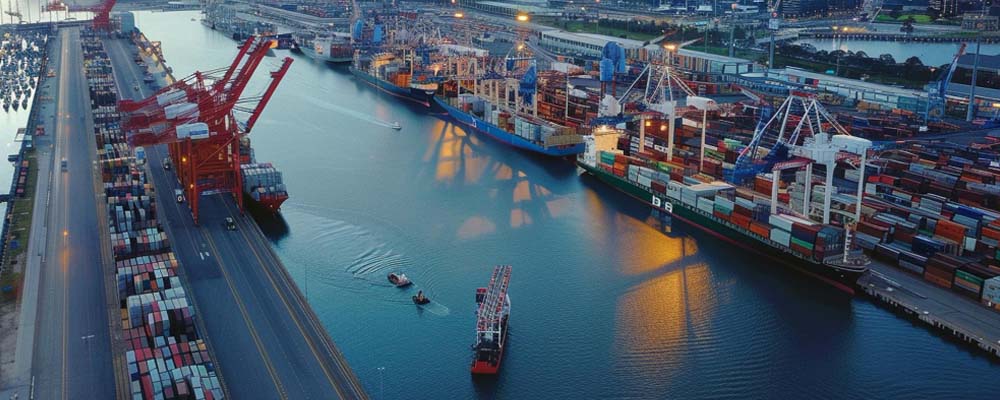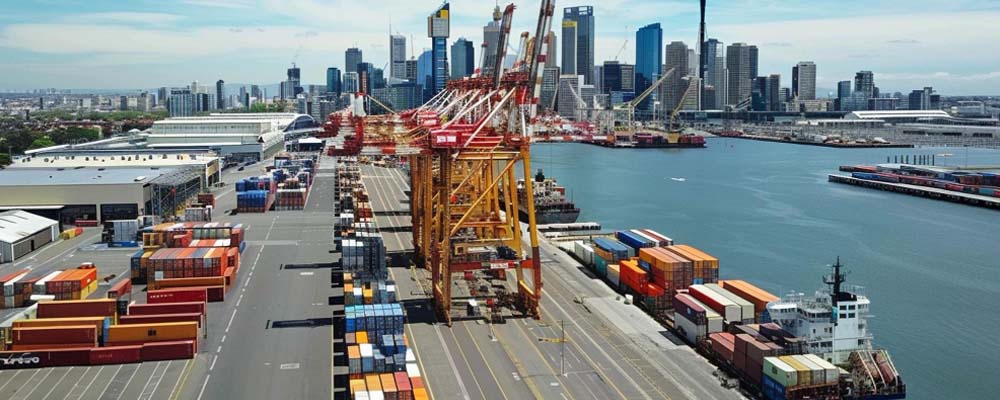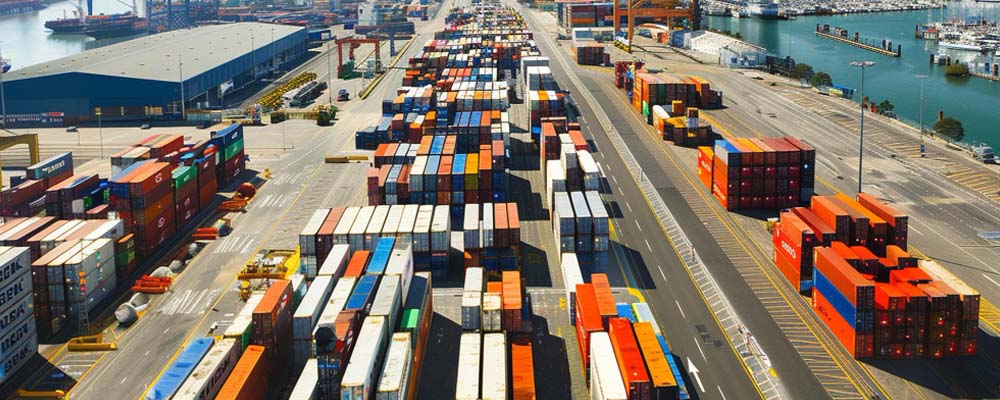
The Port of Melbourne is Australia’s largest and busiest port, serving as a critical gateway for international trade. Understanding its features and operations is essential for efficient navigation and maximizing business opportunities. This comprehensive guide offers key insights into the port’s significance, outlining its economic impact and providing practical tips for operating within this vital hub.
Key Features of the Port of Melbourne
Strategic Location
The Port of Melbourne is strategically located at the mouth of the Yarra River, providing easy access to both domestic and international shipping routes. Its prime location facilitates seamless integration into global supply chains, making it a preferred choice for freight forwarders and logistics providers.
Additionally, the port’s proximity to major highways and railways enhances its accessibility, ensuring efficient transportation to and from the port. This connectivity reduces transit times and costs, benefiting importers, exporters, and manufacturers alike. The strategic location of the Port of Melbourne plays a pivotal role in its success as a leading trade hub.
Advanced Infrastructure
The port boasts state-of-the-art infrastructure, including modern container terminals, bulk cargo facilities, and extensive warehousing options. These facilities are designed to handle a wide range of cargo types, from containerized goods to bulk commodities, ensuring versatility in operations.
The port’s advanced infrastructure includes automated systems for cargo handling, which enhance efficiency and reduce turnaround times. These technological advancements not only improve operational performance but also contribute to the port’s reputation as a reliable and efficient gateway for international trade. The continuous investment in infrastructure underscores the port’s commitment to maintaining its competitive edge.
Capacity and Throughput
With a capacity to handle over 35 million tonnes of cargo annually, the Port of Melbourne is equipped to manage high volumes of trade. Its extensive berthing facilities can accommodate large vessels, ensuring smooth and efficient operations even during peak periods.
The port’s high throughput capacity is supported by its robust logistics network, which includes efficient cargo handling processes and dedicated storage areas. This capacity ensures that businesses can rely on the port to meet their shipping needs without delays or disruptions. The ability to handle substantial cargo volumes underscores the port’s importance in global trade.
Sustainability Initiatives
Sustainability is a key focus at the Port of Melbourne, with various initiatives aimed at reducing its environmental footprint. The port has implemented measures such as shore power for vessels, waste management programs, and initiatives to reduce greenhouse gas emissions.
These sustainability efforts align with global trends towards greener supply chains, making the port an attractive option for environmentally conscious businesses. The port’s commitment to sustainability not only protects the environment but also enhances its reputation as a responsible and forward-thinking trade hub. These initiatives demonstrate the port’s dedication to balancing growth with environmental stewardship.
Customer Support Services
The port offers comprehensive customer support services, including real-time tracking, customs assistance, and dedicated account managers. These services are designed to streamline operations and provide businesses with the support they need to navigate complex shipping processes.
The availability of customer support services ensures that businesses can resolve issues quickly and efficiently, minimizing disruptions to their supply chains. The port’s commitment to customer satisfaction is evident in its proactive approach to addressing the needs of its clients. These services enhance the overall user experience and contribute to the port’s reputation for reliability and efficiency.
 Economic and Global Impact
Economic and Global Impact
Contribution to the Economy
The Port of Melbourne is a significant contributor to both the local and national economies. It supports over 15,000 jobs and generates billions of dollars in economic activity annually. The port’s operations have a ripple effect, stimulating growth in various sectors such as transportation, manufacturing, and retail.
The economic impact of the port extends beyond direct employment, as it also supports numerous ancillary industries. For instance, the port’s activities drive demand for trucking services, warehousing, and distribution centers, creating additional employment opportunities. The port’s contribution to the economy underscores its importance as a key driver of growth and prosperity.
Global Trade Linkages
The port serves as a critical link in global trade networks, connecting Australia to key markets in Asia, Europe, and the Americas. Its strategic location and advanced facilities make it a preferred choice for international shipping lines, enhancing trade flows and fostering economic partnerships.
The port’s role in global trade is further strengthened by its participation in international trade agreements and partnerships. These linkages facilitate seamless movement of goods across borders, reducing barriers to trade and promoting economic cooperation. The port’s global trade linkages highlight its importance as a hub for international commerce.
Innovation and Growth
The Port of Melbourne continues to innovate and expand its capabilities to meet the growing demands of global trade. Recent investments in infrastructure, technology, and sustainability initiatives reflect the port’s commitment to maintaining its competitive edge and supporting future growth.
Innovation at the port includes the adoption of advanced technologies such as blockchain for supply chain transparency and automation for improved efficiency. These advancements position the port as a leader in the maritime industry, capable of adapting to evolving market dynamics. The port’s focus on innovation ensures its continued relevance in a rapidly changing global trade landscape.
Navigating the Port of Melbourne Efficiently
Understanding Port Procedures
To maximize efficiency, it’s crucial to understand the port’s procedures and regulations. This includes knowledge of customs requirements, documentation processes, and cargo handling protocols. Familiarity with these procedures ensures smooth operations and minimizes delays.
Businesses can access detailed information on port procedures through the port’s official website and customer support services. Staying informed about regulatory changes and updates is also essential for maintaining compliance. Understanding port procedures is key to navigating the Port of Melbourne effectively.
Leveraging Technology
Leveraging technology is essential for efficient navigation of the Port of Melbourne. Utilize tools such as real-time tracking, automated documentation, and digital communication platforms to streamline operations and enhance visibility.
Technology solutions such as Enterprise Resource Planning (ERP) systems and Transport Management Systems (TMS) can integrate seamlessly with port operations, providing end-to-end visibility and control. These technologies enable businesses to monitor shipments, manage inventory, and coordinate logistics more effectively. Leveraging technology enhances operational efficiency and reduces the risk of errors and delays.
Building Strong Partnerships
Building strong partnerships with port authorities, shipping lines, and logistics providers can significantly enhance operational efficiency. Collaborative relationships foster better communication, coordination, and problem-solving, ensuring smooth and efficient cargo handling.
Engaging with industry associations and participating in port-related events can also provide valuable networking opportunities. These interactions facilitate knowledge sharing and best practices, contributing to improved operational performance. Building strong partnerships is essential for navigating the Port of Melbourne successfully.
 Conclusion
Conclusion
The Port of Melbourne stands as a vital pillar in Australia’s trade infrastructure, driving economic growth and facilitating global commerce. Understanding its key features, economic impact, and efficient navigation strategies is crucial for businesses seeking to optimize their operations.
By leveraging the port’s advanced infrastructure, sustainability initiatives, and customer support services, businesses can enhance their supply chain efficiency and competitiveness. The Port of Melbourne not only serves as a gateway for trade but also as a catalyst for innovation and growth in the maritime industry.
For businesses aiming to stay ahead in the competitive landscape of global trade, the Port of Melbourne offers unparalleled opportunities. Discover its potential and take the first step towards transforming your logistics operations today.
Contact us to learn how we can support your business in optimizing port utilization and achieving your goals.




 Economic and Global Impact
Economic and Global Impact
 Conclusion
Conclusion



